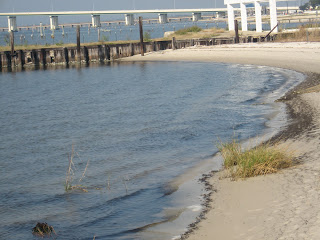
Eric promised me that the crowd assembled to see the film was small, around 25 people, but enthusiastic, and he delivered. Afterward there was a reception with yummy African food, cooked that day by students from the Mary C’s ‘learning kitchen.’ Amazing! I really appreciated and enjoyed this. Several people mentioned to me that they had never seen solar energy used anywhere nearby.
Before scooting out of town the next day, Eric gave me a tour of the Mary C. Naming the town in Mississippi that had actually been Katrina’s epicenter, Eric offered up some controversial (in my mind) views on the intrastate politics of the Katrina cleanup and rebuilding effort, reminding me once again not to underestimate the power of regionalism and local perspectives when it comes to understanding any given political or cultural situation.
I also made a point to get down to the Gulf shore. I spent some time on a pier, watching the pelicans go by, breathing in the air. I was joined by a fisherman and a young boy. The father was teaching his son how to fish. Seemingly they had been out fishing together before, but this was the first time the father had offered any insight into the process, or that the son had been old enough to ask questions. I was reminded of one of my favorite movies, Alamar. The waters here in Ocean Springs hadn’t been contaminated by the oil spill, I was told, but this father-son duo really brought its impact home for me anyway.


I drove from Ocean Springs a quick 90 minutes on I-10 to New Orleans for my final stop on the tour. This was the only place on the tour I had been previously, so it’s unique hotstep was not such a shock.
I spent a couple hours at the Ogden Museum of Art, where my new friend Shawne Major’s work was hanging in the lobby. I loved seeing her intricate work in person, and also really enjoyed Clementine Hunter’s folk art paintings upstairs.
I headed over to Frenchmen Street, where that nights’ screening was to take place. Frenchmen Street blew my mind, as I had never been there before, and felt like I had finally stepped into the real New Orleans. This is where locals come to hang out and play.
At Café Rose Nicaud, an unsuspecting little café, I met Eileen Julian, director of the New Orlans Afrikan Film and Arts Festival and an African Studies Professor at Indiana University. About 25 people showed up to watch the film on the screen that was pulled down inside the café. However, outside, Eileen’s team had arranged for a dual projection scenario in which the film was simultaneously projected onto the side of a giant building across the bustling street! So not only was the café packed with audience members, but outside people were watching the giant projection too, both seated in front of the café, random passers-by, people lounging in front of clubs down the street – amazing! People would stop with their friends to watch 2,5, and 10-minute segments, others literally plopped down on the sidewalk to stay for the whole film! What a great idea this was. I commended Eileen and her partner Joe for this vision, as it really brought in a whole new audience and expanded the impact of the film and the experience of watching it. The sound outside was impressive too, as we were competing against the music emitting from jazz clubs down the street and also crowd noises from an Indian festival organized by Governor Bobby Jindal one street over. Just a typical New Orleans night…

We had a great Q & A, with a large number of filmmakers and activists in the audience. A couple of shorts had played before the feature, and one of those filmmakers joined me for questions as well. A few people in the room had moved to New Orleans after coming to town to help in the rebuilding effort after Katrina, and I felt overall the room connected with the film’s energy and focus on building and empowerment. One woman in particular, an activist in the Lower 9th Ward, was moved by what she saw and wanted to show the film to the community there, and by that I was very honored. I saw a lot of people feeling personally connected to the film, and for that reason I think the film could sustain a longer theatrical run in New Orleans. Thanks to Eileen, Joe, the projection team, and Melanie Grace for making this magical final screening happen.
Since it was my last night on the tour, and since I was in New Orleans, it seemed only appropriate to cap off the adventure with some jazz at Snug Harbor, some new friends, and revelry.

No comments:
Post a Comment